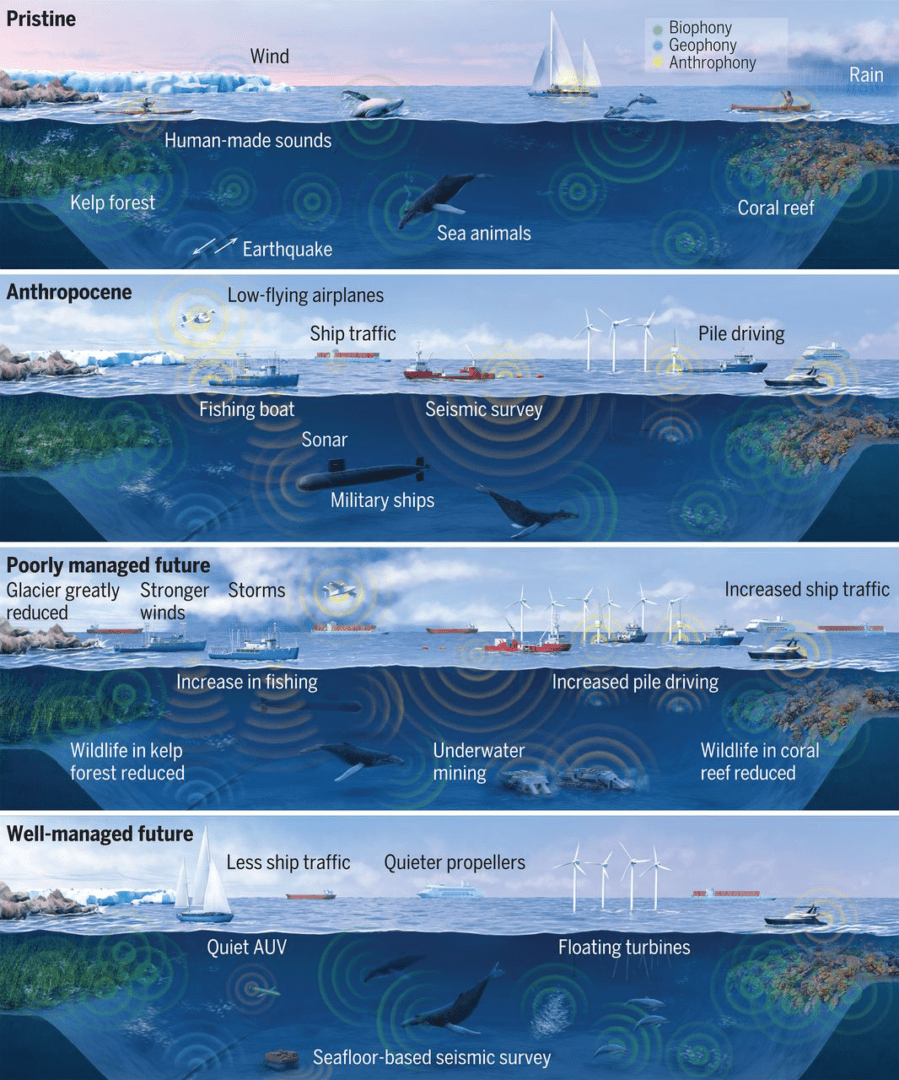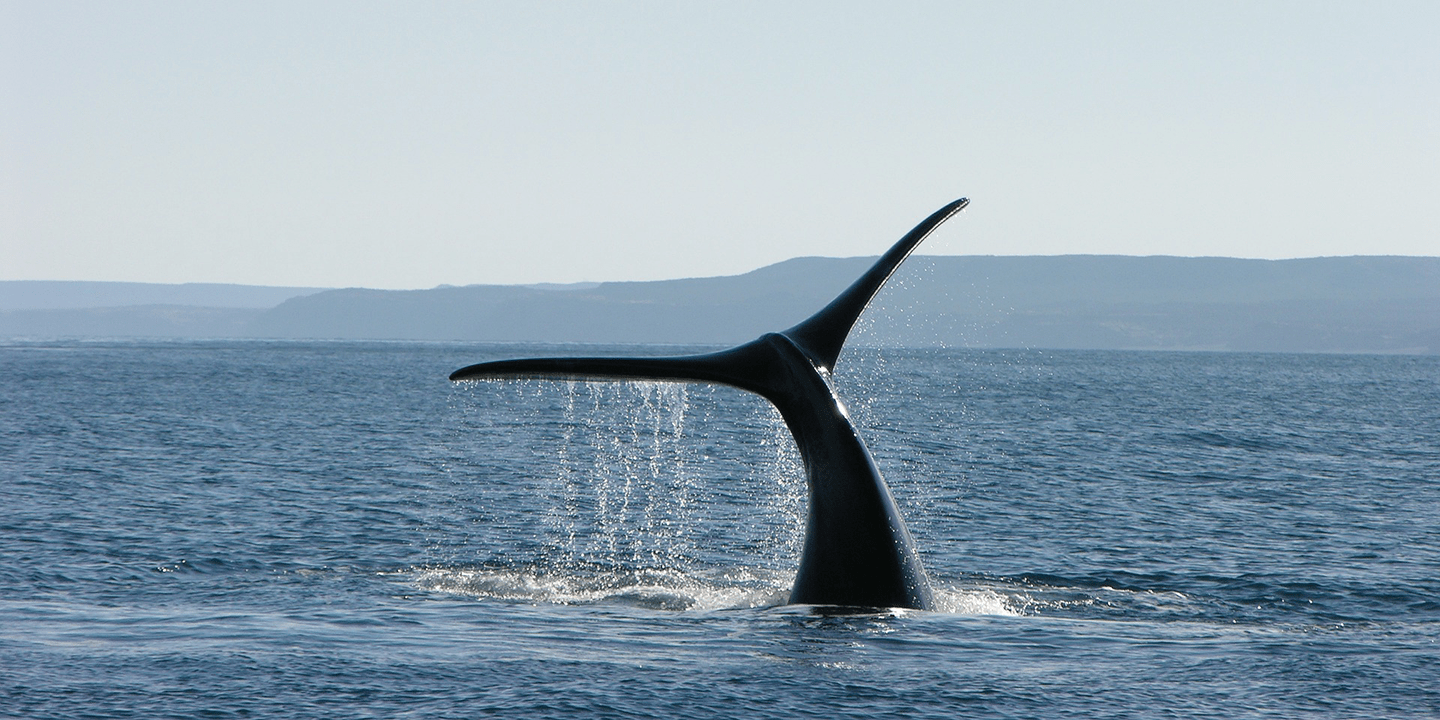A global team of researchers has documented the pervasive impacts of noise on marine animals and ecosystems and identified actions to return to the soundtrack of the healthy ocean.
Rain falls lightly on the ocean’s surface. Marine mammals chirp and squeal as they swim along. The pounding of surf along a distant shoreline heaves and thumps with metronomic regularity. These are the sounds that most of us associate with the marine environment. But the soundtrack of the healthy ocean no longer reflects the acoustic environment of today’s ocean, plagued with human-created noise.
How Man-Made Noise Affects Wildlife
A global team of researchers, including HIFMB scientist Ilse van Opzeeland, set out to understand how man-made noise affects wildlife, from invertebrates to whales, in the oceans, and found overwhelming evidence that marine fauna, and their ecosystems, are negatively impacted by noise, disrupting their behavior, physiology, reproduction and, in extreme cases, causing mortality. They call for human-induced noise to be considered a prevalent stressor at the global scale and for policy to be developed to mitigate its effects.
The research, led by Professor Carlos M. Duarte, distinguished professor at King Abdullah University of Science and Technology (KAUST), and published in the journal Science, is eye opening as to the global prevalence and intensity of the impacts of ocean noise. Since the Industrial Revolution, humans have made the planet, the oceans in particular, noisier through fishing, shipping, infrastructure development and more, while also silencing the sounds from marine animals that dominated the pristine ocean.
The deterioration of habitats, such as coral reefs, seagrass meadows, and kelp beds with climate change and other human pressures, have further silenced their characteristic sound—the soundtrack of a healthy ocean—that guides the larvae of fish and other animals drifting at sea into finding and settling on their habitats. The call home is no longer audible for many ecosystems and regions.
Oceans Need to Be Restored Along Sonic Dimensions
The Anthropocene marine environment, according to the researchers, is polluted by man-made acoustic phenomena, and should therefore be restored along sonic dimensions, as well as along more traditional chemical and climatic ones. Yet, current frameworks to improve ocean health ignore the need to mitigate noise as a pre-requisite for a healthy ocean.
Sound travels far, and quickly, underwater. And marine animals are sensitive to sound, which they use as a prominent sensorial signal guiding all aspects of their behavior and ecology. “This makes the ocean soundscape one of the most important, and perhaps under-appreciated, aspects of the marine environment,” the study states. Their hope is that the evidence presented in the paper will “prompt management actions…to reduce noise levels in the ocean, thereby allowing marine animals to re-establish their use of ocean sound.”
The team set out to document the impact of noise on marine animals and on marine ecosystems around the world. They assessed the evidence contained across more than 10,000 papers to consolidate compelling evidence that man-made noise impacts marine life from invertebrates to whales across multiple levels, from behavior to physiology.

“This unprecedented effort, involving a major tour-de-force, has shown the overwhelming evidence for the prevalence of impacts from human-induced noise on marine animals, to the point that the urgency of taking action can no longer be ignored,” KAUST Ph.D. student Michelle Havlik, said. The research involved scientists from Saudi Arabia, Denmark, the U.S. and the U.K., Australia, New Zealand, the Netherlands, Germany, Spain, Norway and Canada.
Ocean Surface and Deep Sea Are Acoustically Connected
“The deep, dark ocean is conceived as a distant, remote ecosystem, even by marine scientists,” Duarte said, “however, as I was listening, years ago, to a hydrophone recording acquired off the U.S. West Coast, I was surprised to hear the clear sound of rain falling on the surface as the dominant sound in the deep-sea ocean environment. I then realized how acoustically-connected the ocean surface, where most human noise is generated, is to the deep sea; just 1,000 m, less than 1 second apart!”
The takeaway of the review is that “mitigating the impacts of noise from human activities on marine life is key to achieving a healthier ocean.” The KAUST-led study identifies a number of actions that may come at a cost but are relatively easy to implement to improve the ocean soundscape of the ocean and, in doing so, enable the recovery of marine life and the goal of a sustainable use of the ocean.
The use of these noise mitigation measures is low-hanging fruit because unlike many other forms of human pollution, such as emissions of chemical pollutants and greenhouse gases, the effects of noise pollution cease with the reduction of noise, so the benefits are immediate. The study points to the rapid response of marine animals to human closure under COVID-19 as evidence of the potential for rapid recovery from noise pollution.
Using sounds collected from around the world, multimedia artist and study co-author Jana Winderen created a six-minute audio track that demonstrates both the peaceful tranquility and the devastating acoustic aspects of marine life. The research is truly eye-opening, both in its groundbreaking scale and immediacy.
Assets
Click here to listen to a 6-minute soundtrack.
Attribution
Composition for the Ocean Soundscape of the Anthropocene by Jana Winderen 2020
Published by Touch Music/Fairwood Music UK Ltd.
Soundtrack information
- 0:02 – Bearded Seal, Spitsbergen, Norway 77° 4′ 20″ N, 15° 11′ 30″ E.
Recorded by Jana Winderen 2017 - 0:37 – Ice melting sounds under water, Disco Bay, Greenland 69° 0′ 0″ N, 52° 0′ 0″ W. Recorded by Jana Winderen 2007
- 0:48 – Ice moving sounds, Disco Bay, Greenland 69° 0′ 0″ N, 52° 0′ 0″ W.
Recorded by Jana Winderen 2007 - 1:06 – Pilot whale, Madeira, Portugal 32° 43′ 37″ N, 16° 58′ 1″ W.
Recorded by Jana Winderen 2012 - 1:08 – Pilot whale echo location, 1/4 speed, Madeira, Portugal 32° 43′ 37″ N, 16° 58′ 1″ W. Recorded by Jana Winderen 2012
- 1:22 – Norwegian Pollock, Molde fjorden, Norway, 62°43’34.2″N 7°17’52.2″E.
Recorded by Jana Winderen 2008 - 1:34 – Crackling sound, various species crustacea, Panama, 7°28’00.0″N 81°47’00.0»W. Recorded by Jana WInderen 2013
- 1:43 – Bottlenose Dolphins, Miami, USA, 25° 46′ 31″ N, 80° 12′ 32″ W.
Recorded by Jana Winderen 2019 - 2:13 – Humpback whales, Silverbank, Dominican Republic, 20° 32′ 30″ N, 69° 42′ 0″ W. Recorded by Jana Winderen 2013
- 2:56 – Research vessel, Johan Hjort, Barents Sea, 71°02’53.7″N 29°42’57.6»E.
Recorded by Jana WInderen 2007 - 2:56 – Motorboat, Porsgrund. Recorded by Jana Winderen 2019
- 3:03 – Pile driving in Voorschoten N 52.125 E 4.440 in 2011.
Recorded by Niels Bouton - 3:20 – In the background; Pan-tropical spotted dolphin, Placencia, Belize 16°18’04.7″N 88°31’15.6″W. Recorded by Jana Winderen 2012
- 3:30 – Underwater seal scarer audio device, Loch Alsh, Scotland 57°16’32.1″N 5°42’57.7″W. Recorded by Jana Winderen 2013
- 3:34 – Motorboat, Porsgrunn. Recorded by Jana Winderen 2019
- 3:43 – Unidentified estuary fish, Tha Pom, Thailand 8°12’17.4″N 98°45’31.0″E.
Recorded by Jana Winderen 2018 - 4:06 – Motorboat, Porsgrunn. Recorded by Jana Winderen 2019
- 4:03 – Tiger Perch, Gulf of Thailand, 7°02’21.1″N 100°44’41.8″E.
Recorded by Jana Winderen 2019 - 5:14 – Crackeling underwater, various crustaceans, Belize, 16°18’04.7″N 88°31’15.6»W, also some toadfish in the background, Belize, 2012
- 5:50 – Rain on Surface, U.K. Recorded by Jana Winderen 2010
